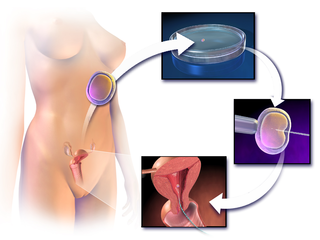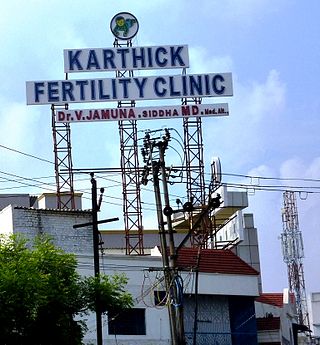Related Research Articles

In vitro fertilisation (IVF) is a process of fertilisation where an egg is combined with sperm in vitro. The process involves monitoring and stimulating a woman's ovulatory process, removing an ovum or ova from their ovaries and letting a man's sperm fertilise them in a culture medium in a laboratory. After the fertilised egg (zygote) undergoes embryo culture for 2–6 days, it is transferred by catheter into the uterus, with the intention of establishing a successful pregnancy.

A parent is either the progenitor of a child or, in humans, it can refer to a caregiver or legal guardian, generally called an adoptive parent or step-parent. The gametes of a parent result in a child, a male through the sperm, and a female through the ovum. Parents who are progenitors are first-degree relatives and have 50% genetic meet. A female can also become a parent through surrogacy. Some parents may be adoptive parents, who nurture and raise an offspring, but are not related to the child. Orphans without adoptive parents can be raised by their grandparents or other family members.

Artificial insemination is the deliberate introduction of sperm into a female's cervix or uterine cavity for the purpose of achieving a pregnancy through in vivo fertilization by means other than sexual intercourse. It is a fertility treatment for humans, and is a common practice in animal breeding, including dairy cattle and pigs.

Assisted reproductive technology (ART) includes medical procedures used primarily to address infertility. This subject involves procedures such as in vitro fertilization (IVF), intracytoplasmic sperm injection (ICSI), cryopreservation of gametes or embryos, and/or the use of fertility medication. When used to address infertility, ART may also be referred to as fertility treatment. ART mainly belongs to the field of reproductive endocrinology and infertility. Some forms of ART may be used with regard to fertile couples for genetic purpose. ART may also be used in surrogacy arrangements, although not all surrogacy arrangements involve ART. The existence of sterility will not always require ART to be the first option to consider, as there are occasions when its cause is a mild disorder that can be solved with more conventional treatments or with behaviors based on promoting health and reproductive habits.

Surrogacy is an arrangement, often supported by a legal agreement, whereby a woman agrees to childbirth on behalf of another person(s) who will become the child's parent(s) after birth. People pursue surrogacy for a variety of reasons such as infertility, dangers or undesirable factors of pregnancy, or when pregnancy is a medical impossibility.
Third-party reproduction or donor-assisted reproduction is any human reproduction in which DNA or gestation is provided by a third party or donor other than the one or two parents who will raise the resulting child. This goes beyond the traditional father–mother model, and the third party's involvement is limited to the reproductive process and does not extend into the raising of the child. Third-party reproduction is used by couples unable to reproduce by traditional means, by same-sex couples, and by men and women without a partner. Where donor gametes are provided by a donor, the donor will be a biological parent of the resulting child, but in third party reproduction, he or she will not be the caring parent.

A sperm bank, semen bank, or cryobank is a facility or enterprise which purchases, stores and sells human semen. The semen is produced and sold by men who are known as sperm donors. The sperm is purchased by or for other persons for the purpose of achieving a pregnancy or pregnancies other than by a sexual partner. Sperm sold by a sperm donor is known as donor sperm.
Egg donation is the process by which a woman donates eggs to enable another woman to conceive as part of an assisted reproduction treatment or for biomedical research. For assisted reproduction purposes, egg donation typically involves in vitro fertilization technology, with the eggs being fertilized in the laboratory; more rarely, unfertilized eggs may be frozen and stored for later use. Egg donation is a third-party reproduction as part of assisted reproductive technology.
A donor offspring, or donor conceived person, is conceived via the donation of sperm or ova, or both.
The main family law of Japan is Part IV of Civil Code. The Family Register Act contains provisions relating to the family register and notifications to the public office.

Same-sex parenting is the parenting of children by same-sex couples generally consisting of gays or lesbians who are often in civil partnerships, domestic partnerships, civil unions, or same-sex marriages.

Fertility clinics are medical clinics that assist couples, and sometimes individuals, who want to become parents but for medical reasons have been unable to achieve this goal via the natural course. Clinics apply a number of diagnosis tests and sometimes very advanced medical treatments to achieve conceptions and pregnancies.
Sperm donation laws vary by country. Most countries have laws to cover sperm donations which, for example, place limits on how many children a sperm donor may give rise to, or which limit or prohibit the use of donor semen after the donor has died, or payment to sperm donors. Other laws may restrict use of donor sperm for in vitro fertilisation (IVF) treatment, which may itself be banned or restricted in some way, such as to married heterosexual couples, banning such treatment to single women or lesbian couples. Donated sperm may be used for insemination or as part of IVF treatment. Notwithstanding such laws, informal and private sperm donations take place, which are largely unregulated.
Fertility tourism is the practice of traveling to another country or jurisdiction for fertility treatment, and may be regarded as a form of medical tourism. A person who can become pregnant is considered to have fertility issues if they are unable to have a clinical pregnancy after 12 months of unprotected intercourse. Infertility, or the inability to get pregnant, affects about 8-12% of couples looking to conceive or 186 million people globally. In some places, rates of infertility surpass the global average and can go up to 30% depending on the country. Areas with lack of resources, such as assisted reproductive technologies (ARTs), tend to correlate with the highest rates of infertility.
Sperm donation is the provision by a man of his sperm with the intention that it be used in the artificial insemination or other "fertility treatment" of one or more women who are not his sexual partners in order that they may become pregnant by him. Where pregnancies go to full term, the sperm donor will be the biological father of every baby born from his donations. The man is known as a sperm donor and the sperm he provides is known as "donor sperm" because the intention is that the man will give up all legal rights to any child produced from his sperm, and will not be the legal father. Sperm donation may also be to known as "semen donation".
Religious response to assisted reproductive technology deals with the new challenges for traditional social and religious communities raised by modern assisted reproductive technology. Because many religious communities have strong opinions and religious legislation regarding marriage, sex and reproduction, modern fertility technology has forced religions to respond.

The legal aspects of surrogacy in any particular jurisdiction tend to hinge on a few central questions:
Law in Australia with regard to children is often based on what is considered to be in the best interest of the child. The traditional and often used assumption is that children need both a mother and a father, which plays an important role in divorce and custodial proceedings, and has carried over into adoption and fertility procedures. As of April 2018 all Australian states and territories allow adoption by same-sex couples.
Surrogacy is legal in Canada provided that it is altruistic (unpaid). The Assisted Human Reproduction Act of 2004 criminalizes commercial surrogacy. The validity of surrogacy contracts and the process for establishing parenthood of the child is governed by provincial law. Quebec law did not recognize surrogacy contracts from 1994 to 2023, and continues to regulate them more strictly, whereas British Columbia has the most permissive laws governing surrogacy. Provinces also vary in the degree to which they compensate surrogacy expenses, such as IVF procedures.

Lesbian, gay, bisexual, and transgender people people wishing to have children may use assisted reproductive technology. In recent decades, developmental biologists have been researching and developing techniques to facilitate same-sex reproduction.
References
- Abelstein, K., Epstein, R., Ross, L. (2013). "Celebrating the "Other" Parent: Mental Health and Wellness of Expecting Lesbian, Bisexual and Queer Non-Birth Parents" [Electronic Version]. Journal of Gay and Lesbian Mental Health, 17, 387-405.
- Adoption Counsel of Canada [1]
- "Box A Celebrating Our Forerunner: The Lesbian and Gay Parenting Activist Groups of the 1970s" (2009) in Who’s your daddy? And other writings on queer parenting, Epstein, Rachel (Ed) (p x). Toronto: Sumach Press.
- Court of Appeal of Ontario, Citation: A.A. vs B.B. (2007). Retrieved September 29, 2014 from http://www.samesexmarriage.ca/docs/abc030107.pdf
- Epstein, Rachel (2009). "Introduction" in Epstein, R (Ed.) (p 13-30), Who's your daddy? And other writings on queer parenting. Toronto: Sumach Press)
- Fascinating Families: Same-Sex Families Raising Children. Retrieved March 27, 2015 from http://www.vanierinstitute.ca/include/get.php?nodeid=2817 Fascinating Familiesn (PDF-file)
- green, d., Epstein, R., Tarasoff, L., "A Guidebook for Lesbian, Gay, Bisexual, Trans and Queer People on Assisted Human Reproduction in Canada" (2012). Retrieved September 30, 2014 from http://www.lgbtqparentingconnection.ca/resources.cfm?mode=3&resourceID=e81cc243-d78a-99e4-91f7-41928d26bae8&subjectID=53%5B%5D
- "Info on Birth Registration for Lesbian/Bi/Queer Women in Ontario" (2009). Retrieved September 29, 2014 from https://web.archive.org/web/20131028074935/http://www.lgbtqparentingconnection.ca/resources.cfm?mode=3&resourceID=1269ae09-3048-8bc6-e84a-16109c061b5d&keywords=
- Love, Heather (2014). "Queer". Transgender Studies Quarterly , 1, 172-176.
- Luce, J. (2010). Beyond Expectation: Lesbian/Bi/Queer Women and Assisted Conception. Toronto: University of Toronto Press.
- Pelka, Suzanne (2009). "The Making and Unmaking of Biological Tier in Lesbian Led Families", in Epstein, R (Ed.) (p x-x), Who's your daddy? And other writings on queer parenting. Toronto: Sumach Press
- Rolfsen, C. (2014 February 10). "Della Wolf is B.C.'s 1st child with 3 parents on birth certificate". CBC News. Retrieved November 2, 2014 from www.cbc.ca/news/canada/british-columbia/della-wolf-is-b-c-s-1st-child-with-3-parents-on-birth-certificate-1.2526584
- "Queer Parenting Info: LGBTQ Adoption" (2014). Retrieved November 2, 2014 from https://web.archive.org/web/20160304000424/http://www.rainbowhealthontario.ca/resources/queer-parenting-info-brochure-series-lgbtq-adoption/
- "Social Media and the LGBT Community." Retrieved March 4, 2015 from https://archive.today/20150320011217/http://www.salzburg.umd.edu/unesco/social-media-and-lgbt-community/
- "Out Online: The Experiences of LGBT Youth on the Internet." Retrieved March 4, 2015 from http://glsen.org/press/study-finds-lgbt-youth-face-greater-harassment-online
- "Meet Sara Graefe." Retrieved March 4, 2015 from http://brucegillespie.com/2014/02/meet-sara-graefe/
- ↑ Frequently Asked Questions (n.d.). Retrieved November 2, 2014 from http://www.adoption.ca/faqs Archived 2018-10-03 at the Wayback Machine